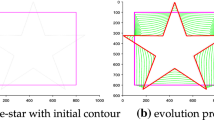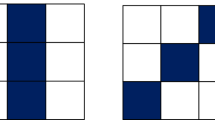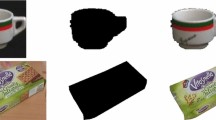Abstract
Parametric active contour model is an efficient approach for image segmentation. However, the high cost of evolution computation has restricted their potential applications to contour segmentation with long perimeter. Extensive algorithm debugging and analysis indicate that the inverse matrix calculation and the matrix multiplication are the two major reasons. In this paper, a novel simple and efficient algorithm for evolution computation is proposed. Motivated by the relationship between the eigenvalues and the entries in the circular Toeplitz matrix, each entry expression of inverse matrix is firstly derived through mathematical deduction, and then, the matrix multiplication is simplified into a more efficient convolution operation. Experimental results show that the proposed algorithm can significantly improve the computational speed by one to two orders of magnitude and is even more efficient for contour extraction with large perimeter.









Similar content being viewed by others
References
Chang, J.X., Gao, X.J., Yang, Y.W., Wang, N.: Object-oriented building contour optimization methodology for image classification results via generalized gradient vector flow snake model. Remote Sens. 13(12), 2406 (2021)
Mewada, H., Al-Asad, J.F., Patel, A., Chaudhari, J., Mahant, K., Vala, A.: A fast region-based active contour for non-rigid object tracking and its shape retrieval. Peer J. Comput. Sci. (2021)
Codari, M., Scarabello, M., Secchi, F., Sforza, C., Baselli, G., Sardanelli, F.: Fully automated contour detection of the ascending aorta in cardiac 2d phase-contrast MRI. Magn. Reson. Imaging 47, 77–82 (2018)
Farhangi, M.M., Frigui, H., Seow, A., Amini, A.A.: 3-d active contour segmentation based on sparse linear combination of training shapes (SCoTS). IEEE Trans. Med. Imaging 36(11), 2239–2249 (2017)
Dong, B., Weng, G., Jin, R.: Active contour model driven by self organizing maps for image segmentation. Expert Syst. Appl. 177, 114948 (2021)
Ding, K., Xiao, L., Weng, G.: Active contours driven by local pre-fitting energy for fast image segmentation. Pattern Recognit. Lett. 104, 29–36 (2018)
Cohen, L.D., Cohen, I.: Finite element methods for active contour models and balloons for 2d and 3d images. IEEE Trans. Pattern Anal. Mach. Intell. 15, 1131–1147 (1991)
Zhu, G., Zhang, S., Zeng, Q., Wang, C.: Gradient vector flow active contours with prior directional information. Pattern Recognit. Lett. 31(9), 845–856 (2010)
Tang, K.: Charged active contour model. In: IEEE International Conference on Systems, Man and Cybernetics, 2009, pp. 163–168. IEEE (2009)
Ntalianis, K.S., Doulamis, N.D., Doulamis, A.D., Kollias, S.D.: Multiresolution gradient vector flow field: a fast implementation towards video object plane segmentation. In: IEEE International Conference on Multimedia and Expo(ICME), pp. 1–3. IEEE (2001)
Han, X., Xu, C., Prince, J.L.: Fast numerical scheme for gradient vector flow computation using a multigrid method. IET Image Proc. 1(1), 48–55 (2007)
He, Z., Kuester, F.: GPU-based active contour segmentation using gradient vector flow. In: Advances in Visual Computing, pp. 191–201. Springer (2006)
Smistad, E., Elster, A.C., Lindseth, F.: Real-time gradient vector flow on GPUs using OpenCL. J. Real-Time Image Proc. 10(1), 67–74 (2015)
Li, J., Zuo, W., Zhao, X., Zhang, D.: An augmented lagrangian method for fast gradient vector flow computation. In: IEEE International Conference on Image Processing (ICIP), pp. 1525–1528. IEEE (2011)
Ren, D., Zuo, W., Zhao, X., Lin, Z., Zhang, D.: Fast gradient vector flow computation based on augmented Lagrangian method. Pattern Recognit. Lett. 34(2), 219–225 (2013)
Kass, M., Witkin, A., Terzopoulos, D.: Snakes: active contour models. Int. J. Comput. Vis. 1(4), 321–331 (1988)
Wang, Y., Teoh, E.K.: Object contour extraction using adaptive b-snake model. J. Math. Imaging Vis. 24(3), 295–306 (2006)
Ray, N., Chanda, B., Das, J.: A fast and flexible multiresolution snake with a definite termination criterion. Pattern Recognit. 34(7), 1483–1490 (2001)
Tang, K., Zhou, X.: Evolution algorithm of parametric active contour model based on Gaussian smoothing filter. Mach. Vis. Appl. 33(83), 1–9 (2022)
Hou, Z., Han, C.: Force field analysis snake: an improved parametric active contour model. Pattern Recognit. Lett. 26(5), 513–526 (2005)
Bini, D.A., Dendievel, S., Latouche, G., Meini, B.: Computing the exponential of large block-triangular Block–Toeplitz matrices encountered in fluid queues. Linear Algebra Appl. 502, 387–419 (2016)
Acknowledgements
This work is supported by the National Natural Science Foundation of China (No. 52008340), Natural Science Foundation of Sichuan, China (2022NSFSC0443), and the High-end Talent Fund of the School of XiHua University(No. Z201130).
Author information
Authors and Affiliations
Contributions
Xiaojun Zhou gave funding support, Lin Lang involved in language proofreading, and Kelun Tang wrote the main manuscript text prepared all figures. All authors reviewed the manuscript.
Corresponding author
Ethics declarations
Conflict of interest
The authors declare no competing interests.
Additional information
Publisher's Note
Springer Nature remains neutral with regard to jurisdictional claims in published maps and institutional affiliations.
Appendix
Appendix
Rights and permissions
Springer Nature or its licensor (e.g. a society or other partner) holds exclusive rights to this article under a publishing agreement with the author(s) or other rightsholder(s); author self-archiving of the accepted manuscript version of this article is solely governed by the terms of such publishing agreement and applicable law.
About this article
Cite this article
Tang, K., Lang, L. & Zhou, X. Equivalent convolution strategy for the evolution computation in parametric active contour model. J Real-Time Image Proc 21, 71 (2024). https://doi.org/10.1007/s11554-024-01434-8
Received:
Accepted:
Published:
DOI: https://doi.org/10.1007/s11554-024-01434-8




